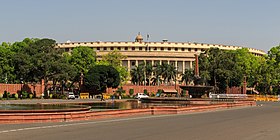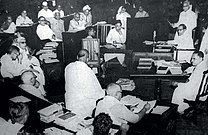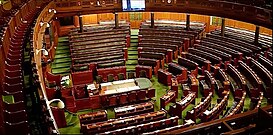Samvidhan Sadan
| Samvidhan Sadan | |
|---|---|
संविधान सदन | |
 Old Parliament House, seen from Kartavya Path | |
 Old Parliament House, seen from Kartavya Path | |
| Former names | Parliament House |
| Alternative names | Old Parliament Building |
| General information | |
| Status | Retired and waiting for heritage restoration |
| Type | Heritage |
| Architectural style | Lutyens' Delhi |
| Location | New Delhi |
| Address | Sansad Marg, New Delhi, National Capital Territory of Delhi |
| Town or city | New Delhi |
| Country | |
| Coordinates | 28°37′02″N 77°12′29″E / 28.6172°N 77.2081°ECoordinates: 28°37′02″N 77°12′29″E / 28.6172°N 77.2081°E |
| Current tenants | Museum of Indian Democracy |
| Groundbreaking | 1921 by Duke of Connaught |
| Construction started | 1921 |
| Completed | 18 February 1927 |
| Opened | 18 February 1927 by Viceroy of India Irwin |
| Owner | Government of India |
| Design and construction | |
| Architect | |
| Other information | |
| Seating capacity | 790 |
| Public transit access |
|
The Samvidhan Sadan (IAST: संविधान सदन)[1] in New Delhi, formerly known as the Old Parliament Building and even more formerly the Parliament Building, was the seat of the Imperial Legislative Council between 18 January 1927 and 15 August 1947, the Constituent Assembly of India between 15 August 1947 and 26 January 1950, and the Parliament of India between 26 January 1950 and 18 September 2023. For 73 years, it housed the Lok Sabha and the Rajya Sabha, the lower and upper houses respectively in India's bicameral parliament.
The building was designed by British architects Edwin Lutyens and Herbert Baker and was constructed between 1921 and 1927. It was opened in January 1927 as the seat of the Imperial Legislative Council. Following the British withdrawal from India, it was taken over by the Constituent Assembly of India, and then by the Indian Parliament once India's Constitution came into force on 26 January 1950 with India becoming a republic.[2]
The New Parliament House, built near this building on a triangular plot from 2020 to 2023 was inaugurated on 28 May 2023. It was built as part of the Indian government's Central Vista Redevelopment Project.
History[edit]

The building was designed by the British architects Sir Edwin Lutyens and Sir Herbert Baker in 1912-1913, and completed in 1927.[3]
The foundation stone was laid by HRH Prince Arthur, Duke of Connaught and Strathearn, in February 1921. It took five years to complete the building. On 18 January 1927, Sir Bhupendra Nath Mitra, Member of the Governor-General's Executive Council, in charge of the Department of Industries and Labour, invited Lord Irwin, then Viceroy of India to inaugurate the building. The third session of Central Legislative Assembly was held in this house on 19 January 1927.[4][5]
After independence, the house served as the seat of the Constituent Assembly from 1947–1950. The Constitution of India was created here, under the presidency of Rajendra Prasad.

Two floors were added to the structure in 1956 due to a demand for more space.[6] In subsequent years it got some renovations. Air conditioners, digital screens and a digital voting system were added.
The Parliament Museum, opened in 2006, stands next to the Parliament House, in the building of the Parliamentary Library.
Description[edit]
The perimeter of the building is circular, with 144 columns on the outside. At the centre of the building is the circular Central Chamber, and surrounding this Chamber are three semicircular halls that were constructed for the sessions of the Chamber of Princes (now used as the Library Hall), the State Council (now used for the Rajya Sabha), and the Central Legislative Assembly (now used for the Lok Sabha). The parliament is surrounded by large gardens and the perimeter is fenced off by sandstone railings (jali).[7] The current building is planned to be converted into a Museum of Democracy after the new Parliament House is operational.[8]
New Parliament House[edit]
Background[edit]
Proposals for a new parliament building to replace Parliament House emerged in the early 2010s as a result of questions being asked about the stability of the original structure.[9] In 2012, a committee was assembled by the then-Speaker, Mira Kumar, to suggest and assess several alternatives to the usage of the building.[10]
Commencement[edit]
In 2019, the Indian government launched the Central Vista Redevelopment Project, a multi-billion dollar project to redevelop the Central Vista, India's central administrative area near Raisina Hill, New Delhi. The construction of a new parliament building, as well as redeveloping the Rajpath will create a new office and residence for the Indian prime minister, as well as combining all ministerial buildings in a single central secretariat.[11]
The groundbreaking ceremony for the new building was held in October 2020 and the foundation stone was laid on 10 December 2020.[12][13]
Museum of Democracy[edit]

After the inauguration of the New Parliament House, this old parliament building was converted to a Museum of Democracy.[14]
Incidents[edit]
Bombing by Bhagat Singh[edit]
At 8 April 1929, Hindustan Socialist Republican Association (HSRA) revolutionary Bhagat Singh threw low-intensity bombs from visitors' gallery into the hall of the Central Legislative Assembly (later, the chamber of the Lok Sabha). Batukeshwar Dutt was also with him, but did not throw any bomb. Both of them hurled pamphlets and shouted slogans against the British government such as "Down with imperialism!", "Workers of the world, unite!", and "Long live the Revolution!". They were arrested. Singh, who was the mastermind, was inspired by French anarchist Auguste Vaillant who had bombed the French Chamber of Deputies in the year 1893. HSRA's revolutionaries intended to spread ideas of revolution and inspire Indians to fight against the Government. Due to the explosions, minor injuries were inflicted on the people sitting in the chamber.[15][16]
2001 terror attack[edit]
On 13 December 2001, five terrorists from Lashkar-e-Taiba (LeT) and Jaish-e-Mohammed (JeM) - two Pakistan-raised terrorist organisations - entered the grounds of Parliament and attempted to invade the building. They were all killed outside the building. The attack led to the deaths of six Delhi Police personnel, two Parliament Security Services personnel, and a gardener – nine others in total – and led to increased tensions between India and Pakistan, resulting in the 2001–02 India–Pakistan standoff.[17]
Gallery[edit]
Lord Mountbatten addressing the Chamber of Princes as Viceroy in 1947.
A Constituent Assembly of India meeting in 1950.
Indian Prime Minister Morarji Desai listens to U.S President Jimmy Carter as he addresses the Indian Parliament House in 1978.
Erstwhile Lok Sabha chamber.
See also[edit]
References[edit]
- ↑ PTI (19 September 2023). "Old Parliament building renamed 'Samvidhan Sadan'". BusinessLine. Retrieved 19 September 2023.
- ↑ Anisha Dutta (31 January 2020). "New Parliament complex may seat 1,350 members". Retrieved 1 February 2020.
- ↑ Ghosal, Jayanta (27 September 2019). "Sansad Bhavan to be revamped; all MPs to get separate offices". India TV. Retrieved 26 October 2020.
- ↑ "History of the Parliament of Delhi". delhiassembly.nic.in. Retrieved 13 December 2013.
- ↑ Chopra, Prabha (1976). "Delhi Gazetteer".
- ↑ Patel, Shivam; Lakhani, Somu (24 January 2020). "Diversity, efficiency, flexibility: The brief for redeveloping New Delhi's Central Vista". The Indian Express. Retrieved 5 January 2021.
- ↑ "Parliament House: 144 pillars of pride". Hindustan Times. 7 June 2011. Retrieved 20 August 2018.
- ↑ "Construction of new Parliament building: Shaping the Central Vista". The Financial Express. 16 January 2021. Retrieved 16 January 2021.
- ↑ "Delhi may see a new Parliament building". The Times of India. 13 July 2012. Archived from the original on 15 July 2012. Retrieved 13 December 2013.
- ↑ Firstpost (13 July 2012). "Speaker sets up panel to suggest new home for Parliament". Firstpost. Retrieved 15 August 2012.
- ↑ "Central Vista Redevelopment Project". Drishti IAS. 23 April 2020. Retrieved 22 September 2020.
- ↑ PTI (1 October 2020). "Groundwork For New Parliament Building Begins, To Be Completed In 22 Months". BloombergQuint. Retrieved 6 March 2021.
- ↑ Mathew, Liz (6 December 2020). "PM Modi to lay foundation stone for new Parliament building on December 10". The Indian Express. New Delhi. Retrieved 6 December 2020.
- ↑ "New Parliament Building May Not be Called Parliament House, May Get a New Name". 25 May 2023.
- ↑ "Remembering..." The Economic Times. Archived from the original on 29 May 2023.
- ↑ "Simon was present...when hurled bombs". The Print. Archived from the original on 27 May 2023.
- ↑ "Terrorists attack Parliament; five intruders, six cops killed". rediff.com. 13 December 2001. Retrieved 13 December 2013.
External links[edit]






